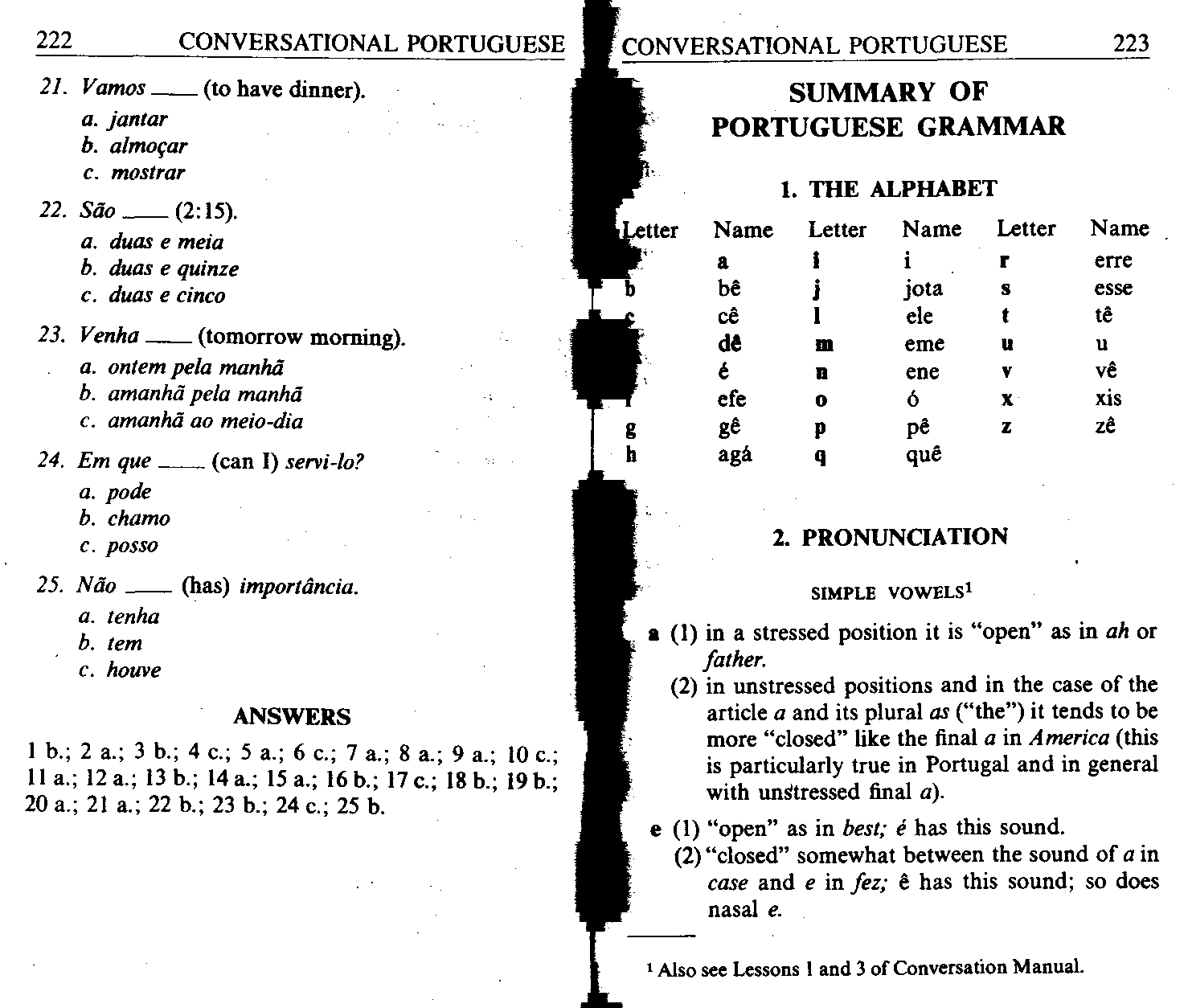Summary p222

222 CONYERSATIONAL PORTUGUESE
21. Vamos_(to have dinner).
a. jantar
b. almoęar
c. mostrar
22. Sao_(2:15).
a. duas e meia
b. duas e ąuinze
c. duas e cinco
23. Venka_(tomorrow moming).
a. ontem pela manka
b. amanhd pela manka
c. amanhd ao meio-dia
24. Em que_____ (can I) servi-lo?
a. pode
b. chamo
c. posso
25. Nao_(has) importancia.
a. tenha
b. tern
c. houve
ANSWERS
I b.; 2 a.; 3 b.; 4 c.; 5 a.; 6 c.; 7 a.; 8 a.; 9 a.; 10 c.;
II a.; 12 a.; 13 b.; 14 a.; 15 a.; 16 b.; 17 c.; 18 b.; 19 b.; 20 a.; 21 a.; 22 b.; 23 b.; 24 c.; 25 b.
SUMMARY OF PORTUGUESE GRAMMAR
1. THE ALPHABET
tter
|
Name |
Letter |
Name |
Letter |
Name |
|
a |
i |
i |
r |
erre |
|
be |
j |
jota |
s |
esse |
|
ce |
i |
ele |
t |
te |
|
de |
m |
eme |
u |
u |
|
ć |
n |
ene |
V |
ve |
|
efe |
0 |
ó |
X |
xis |
|
g$ |
P |
p€ |
z |
z e |
|
agi |
que |
b
g
h
2. PRONUNCIATION
SIMPLE yOWELS1
j a (1) in a stressed position it is “open” as in ah or father.
(2) in unstressed positions and in the case of the article a and its plural as (“the”) it tends to be morę “closed” like the finał a in America (this is particularly true in Portugal and in generał with unstressed finał a).
e (1) “open” as in best; e has this sound.
(2) “closed” somewhat between the sound of a in case and e in fez; e has this sound; so does nasal e.
Also see Lessons 1 and 3 of Conversation Manuał.
Wyszukiwarka
Podobne podstrony:
Summary p256 256 CONYERSATIONAL PORTUGUESE 21. SOME CONJUNCTIONS ainda que assim que ate
Summary p284 284 CONYERSATIONAL PORTUGUESE finał a changed to e and finał e changed to a (but also
Summary p248 248 CONYERSATIONAL PORTUGUESE 19. PRONOUNS Pronouns have varying forms depending on w
Summary p242 242 CONYERSATIONAL PORTUGUESE seu can also be used to translate “his,” “her,” “their.
Summary p250 250 CONYERSATIONAL PORTUGUESE CONYERSATIONAL PORTUGUESE_ 251 (te) I
Summary p258 258 CONYERSATIONAL PORTUGUESE 23. ADYERBS 1. Some Portuguese adverbs are formed by ad
Summary p268 268 CONYERSATIONAL PORTUGUESE 2. The personal infinitiye has endings which make it ea
Summary p270 270 CONYERSATIONAL PORTUGUESE 2. to indicate a condition, or action
Summary p288 288 CONYERSATIONAL PORTUGUESE Although both forms are used, therc is a tend-ency for
Summary p300 300 CONYERSATIONAL PORTUGUESE cated, the change given will pertain to those forms of
Summary p304 304 CONYERSATIONAL PORTUGUESE Some of the other verbs in -gar: apagar to put out, e
Summary p306 306 CONYERSATIONAL PORTUGUESE 7. Verbs ending in -guer ot -guir In these verbs gu cha
Summary p310 310 CONYERSATIONAL PORTUGUESE Eleger to elect 1. PAST. PART.! elegido and eleito
Summary p224 224 CONYERSATIONAL PORTUGUESE (3) variations occur in different areas: a.
Summary p226 226 CONYERSATIONAL PORTUGUESH CONYERSATIONAL PORTUGUESE 227 d g g h j I I Ut m as d i
Summary p230 230 CONYERSATIONAL PORTUGUESE 3, The cedilla (cedilha) is used with
Summary p234 234 CONYERSATIONAL PORTUGUESE k. with parts of the body and articles of clothing inst
Summary p236 236 CONYERSATIONAL PORTUGUESE De and em combine with the demonstrative forms (see GS2
Summary p238 238 CONYERSATIONAL PORTUGUESE 13. MASCULINE AND FEMININE 238 CONYERSATIONAL PORTUGUES
więcej podobnych podstron